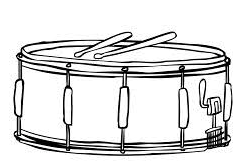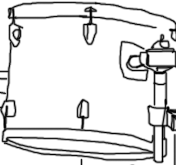
Drum Course Beginner Lesson 3
Overview"what this lesson is about"
Tuning A Bass Drum
In this lesson we are going to take a close look on how to tune the bass drum using some simple and effective techniques.
Watch The Video
Let's get started!
Step 1 -
As the lugs have already been finger tightened, take a drum key and begin to tighten each lug in 1/4 or 1/2 turns at a time on the skin that the kick pedal will be playing (the batter head). Remember to spread the tension evenly over the drumhead by moving in opposites.
Step 2 -
Once each lug has been tightened by roughly 1-2 full turns then press the head lightly, not too much as this may affect the tension of the lugs. When doing this the skin should have some flexibility of at least 1 inch. If so this should be tight enough.
Step 3 -
Now approach the front skin (the resonant head) of the bass drum with the same tightening process. Some drummers like to carefully cut a whole in the resonant head depending on user preference. This is commonly done to make the bass drum more punchy, to reduce resonance and to allow flexibility of micing in a studio environment.
Step 4 -
Once both skins have been prepared it is time to test the bass drum sound with either a pedal or a cymbal mallet. Some drummers like to place a pillow or some rolled up towels inside the drum pushed up against the heads to reduce resonance further.
Step 5 -
Once this process has been applied it will then be a case of testing the drums and adjusting to user preference.
Overview"what this lesson is about"
Tuning A Snare Drum
In this lesson we are going to take a close look on how to tune the snare drum using some simple and effective techniques.
Watch The Video

Let's get started!
Step 1 -
As the lugs have already been finger tightened, take a drum key and begin to tighten each lug on the top head (the batter head) in 1/4 or 1/2 turns at a time. Remember to spread the tension evenly over the drumhead by moving in opposites.
Step 2 -
Once each lug has been tightened by roughly 1-2 full turns use the drum key to tap near each lug to see if they produce a pitch. If there is no sign of a pitch then keep tightening the lugs. If there is a pitch to each lug then they'll need to be balanced. When doing this it's important to ensure that the bottom head has been muted to avoid confusion of pitch between the two heads.
Step 3 -
Balancing the pitches involves tapping next to each lug and working towards the more prominent pitch coming from the lugs. This involves experimentation so do not be alarmed if this takes some time.
Step 4 -
Once the pitches have been balanced then repeat this process for the bottom head (the resonant head) of the drum. Please ensure that the snares have been removed from the drum and put somewhere safe until they are needed again.
Step 5 -
Once both heads have been tuned, take a cymbal mallet and hit the top head of the drum to check the tone that the drum produces. If this suits requirements then the snares will need to be reattached to the drum and tightened to preference to complete the tuning process
Step 6 -
Once this process has been applied it will then be a case of testing the drums and adjusting to user preference.
Overview"what this lesson is about"
Tuning A Tom Drum
In this lesson we are going to take a close look on how to tune the tom drums using some simple and effective techniques.
Watch The Video

Let's get started!
Step 1 -
As the lugs have already been finger tightened, take a drum key and begin to tighten each lug in 1/4 or 1/2 turns at a time. Remember to spread the tension evenly over the drumhead by moving in opposites.
Step 2 -
Once each lug has been tightened by roughly 1-2 full turns use the drum key to tap near each lug to see if they produce a pitch. If there is no sign of a pitch then keep tightening the lugs. If there is a pitch to each lug then they'll need to be balanced. When doing this it's important to ensure that the bottom head has been muted to avoid confusion of pitch between the two heads.
Step 3 -
Balancing the pitches involves tapping next to each lug and working towards the more prominent pitch coming from the lugs. This involves experimentation so do not be alarmed if this takes some time.
Step 4 -
Once the pitches have been balanced then repeat this process for the other head of the drum.
Step 5 -
When balancing the pitches of both heads it is common practice to tune the bottom head (the resonant head) higher than the top head (the batter head). This will ensure that the overtones of the drum round off nicely.
Step 6 -
Once this process has been applied it will then be a case of testing the drums and adjusting to user preference.